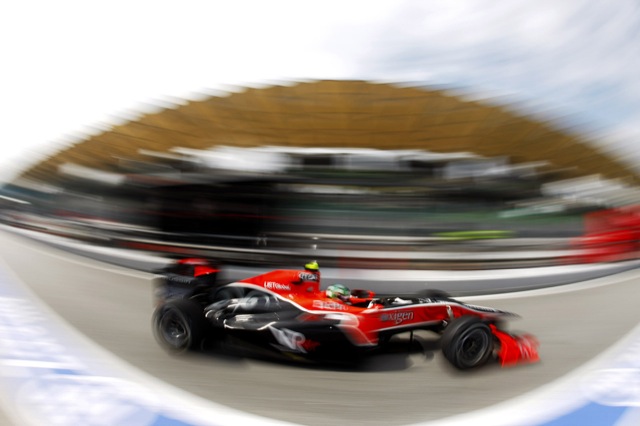Please note this post was written in 2006 and is therefore out of date.
It seems too far into the future to be discussing the 2009 championship, but in reality it is only two years away, and while much may change in that time, the make up of the season is already beginning to take shape, particulrly the rules. Formula One’s governing body – the FIA – have quietly released the 2009 Rules & Regulations on their website. While many changes have been widely rumoured and reported, this is the first time they have been published for the public to read. The general jist of what will be happening come 2009 is detailed below.
– A change in the size of the cars: The maximum width will increase from 1800mm to 2000mm, with the minimum width being 1980mm. The wheels will also increase in size, from 355mm to 365mm at the front, and from 380mm to 460mm.
– A change to the weight: To accommodate the energy recovery systems, the minimum weight of the cars is increasing from 600kg to 605kg.
– Standard ECUs will be introduced, and Traction Control will therefore be banned. Traction Control made a come back recently because the FIA found it hard to police. But with a standardisation in the Engine Control Units, the stewards can better monitor what electronic gizmos the teams are employing.
– Lights inside the cockpit to warn drivers of flags being shown on parts of the circuits. One issue that has been going on for a while is the difficulty drivers have of seeing flags being waved on the side of the circuit when they are driving at high speed. The lights would corrospond with the flag being waved, and go out when the driver has passed the affected area.
– Pit-to-car radios must no longer be scrambled. This is probably to aid the television companies as the recent introduction of radio messages during live broadcasts has proved popular. Even Fisichella’s colourful language, although the FIA now delay the broadcast to filter out such use of words.
Although these rules will not come into effect until 2009, the teams are surely already preparing as the changes will be quite dramatic. The increase in width of both the car and the tyres will aid grip and balance, but the FIA will undoubtedly have counter measures (aerodynamic related) to ensure speeds do get too out-of-control.
There have been changes made to the 2007 season as well, and these will be discussed in January when the build up to the next season begins.
Thanks to Howard at MarkWebberBlog.com for the heads up.


















The majority of the new regs appear to give more ‘sport’ to the sport which is a good thing. I’m particularly keen on seeing aero improvements to dissipate the wash to allow cars to creep closer to each other, but when that happens???. Adding to the wheel-track should give better cornering stability which is something they’ve been slowing so Im wondering if the tyres get penalised to reflect the increase in performance.
It’s a shame that the ECU technology is being standardised as I’m a fan of the innovation of the sport, not so much the drivers. F1 is the pinnacle of sporting technology and should remain so. Ultimately, the weaknesses are the tyres and the tracks themselves. Going 300mph+ in Monaco wouldn’t work so performance needs to be balanced with safety.
I’m sooo looking forward to next season, particularly because of the balance between cars and drivers. Theres a genuine sense of “who’s going to win the title next year?”.
I’m sure i’ve read somewhere,that the FIA are considering returning to full slick tyre’s for the 2008 season? (by the way, the link to the FIA above isn’t working) Great site Ollie.
Thanks for the comment Marts – silly me thinking the FIA would allow their site the site load sans www! Now fixed.
Yeah, I also heard mumourings about a return to full slicks, and the A1GP series has returned to the tyre of choice. But in all honesty, I cannot see it happening – slick tyres would cause cornering speeds to go through the roof, and the current trend of decreasing aero grip is not enough at the moment to counter this. Slicks would surely increase the chances of overtaking, but also the chances of having a high speed accident.
Ed said above something which sums it all up quite well: